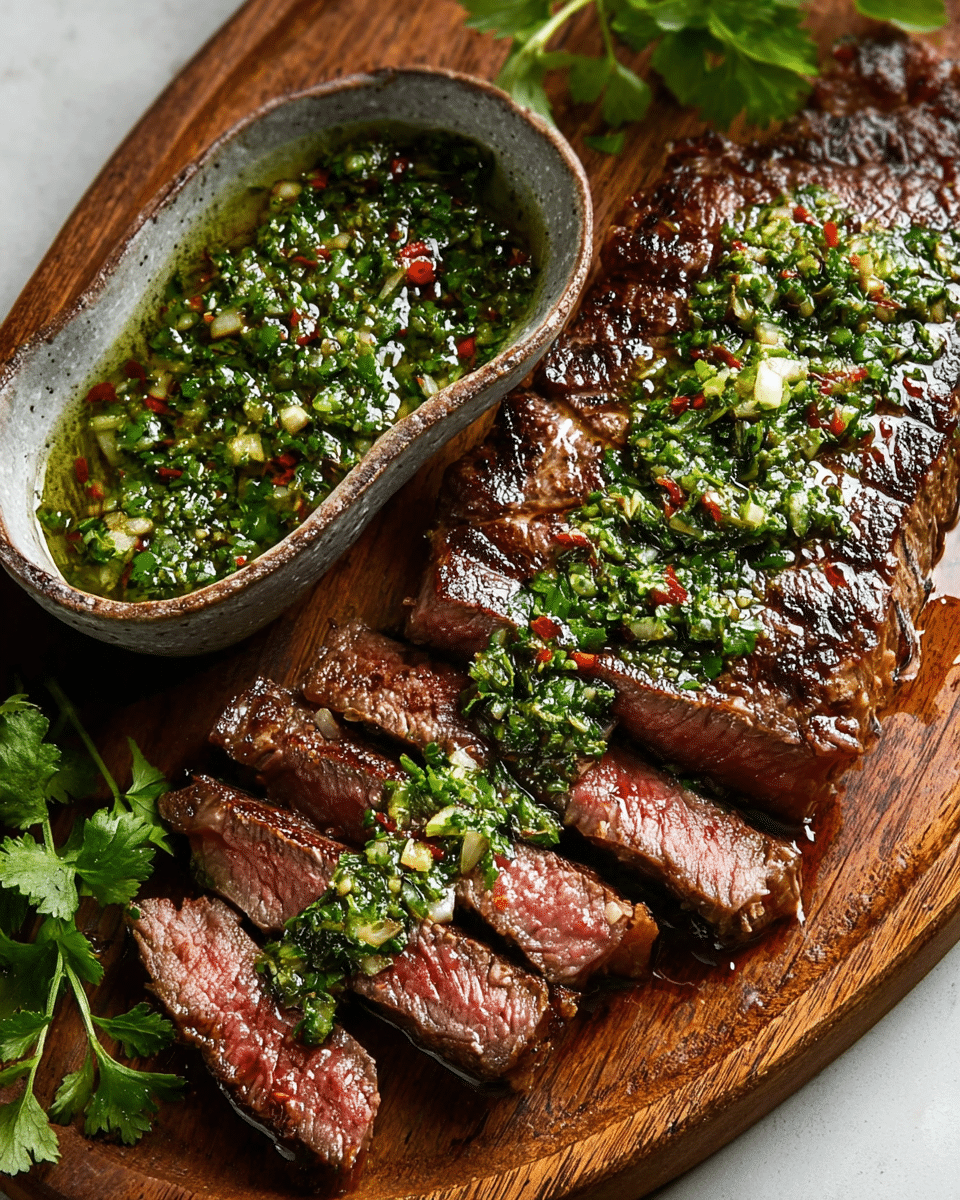The bold flavors of Argentina come alive with this juicy Chimichurri Steak. Perfectly seared to form a rich, golden crust and sliced thinly against the grain, the meat is tender, flavorful, and elevated with a vibrant chimichurri sauce made with fresh herbs, garlic, and red wine vinegar.
This dish transforms an ordinary steak dinner into a restaurant worthy experience with minimal effort. Whether you’re hosting guests or just treating yourself, the harmony between the rich beef and tangy chimichurri makes this a meal you’ll want to make again and again. Pair it with roasted potatoes, crusty bread, or a simple salad for a complete and satisfying feast.
Full Recipe:
Ingredients:
For the Steak:
-
2 ribeye or New York strip steaks (about 1.5 inches thick)
-
2 tablespoons olive oil
-
Salt, to taste
-
Freshly ground black pepper, to taste
For the Chimichurri Sauce:
-
1 cup fresh parsley leaves, finely chopped
-
3 garlic cloves, minced
-
2 tablespoons fresh oregano leaves, chopped (or 1 tbsp dried oregano)
-
½ cup extra virgin olive oil
-
2 tablespoons red wine vinegar
-
½ teaspoon red pepper flakes
-
½ teaspoon salt (or to taste)
-
¼ teaspoon freshly ground black pepper
Directions:
-
Let steaks sit at room temperature for 30–45 minutes before cooking.
-
Combine parsley, garlic, and oregano in a medium bowl. Stir in olive oil, red wine vinegar, red pepper flakes, salt, and pepper. Let sit for at least 10 minutes at room temperature.
-
Pat steaks dry and season generously with salt and black pepper on both sides.
-
Heat a cast-iron skillet or grill pan over high heat for 3–5 minutes. Add olive oil and swirl to coat.
-
Sear steaks undisturbed for 3–4 minutes per side for medium-rare, adjusting time as needed.
-
Transfer steaks to a cutting board, cover loosely with foil, and let rest for 5–10 minutes.
-
Slice steaks against the grain into ¼-inch slices.
-
Plate and drizzle generously with chimichurri sauce. Serve with extra sauce on the side.
Prep Time: 15 minutes | Cooking Time: 10 minutes | Total Time: 25 minutes
Kcal: 590 kcal | Servings: 2 servings
The Bold, Irresistible Allure of Chimichurri Steak
Chimichurri Steak isn’t just another meat dish it’s a celebration of flavor, a fusion of vibrant herbs, aromatic garlic, and tangy vinegar that transforms even the simplest cut of beef into a mouthwatering culinary experience. Rooted deeply in Argentine tradition, Chimichurri Steak has found its way onto menus around the world, beloved for its bold character and ease of preparation. It’s the kind of meal that feels both rustic and refined, ideal for both a weeknight dinner and a weekend feast.
This article explores the origins of Chimichurri, its dynamic flavor profile, why it has earned a place in so many home kitchens, and how you can elevate your own version of this iconic dish with just a few thoughtful touches.
A Taste of Argentina
The heart of Chimichurri Steak lies in its sauce an uncooked, herbaceous blend often referred to as the “pesto of Argentina.” Though its exact origin remains debated among culinary historians, most agree that chimichurri was developed in Argentina or Uruguay by gauchos (South American cowboys) as a simple, shelf-stable sauce to accompany grilled meats, or asado. Unlike traditional steak sauces that are thick and rich, chimichurri is fresh, light, and acidic, providing balance to fatty cuts of meat.
In its most traditional form, chimichurri consists of fresh parsley, garlic, oregano, red wine vinegar, olive oil, and a touch of chili. It can be made green (chimichurri verde) or red (chimichurri rojo), depending on the herbs and spices used. In the recipe you’re featuring, the green version is used a vibrant, punchy blend that provides a refreshing contrast to the rich, seared beef.
Why Chimichurri Steak Has Captured Global Attention
In recent years, Chimichurri Steak has surged in popularity across North America and Europe not only in Latin restaurants but in home kitchens as well. One reason is its remarkable versatility. The sauce is easy to prepare and doesn’t require special equipment. It’s also highly customizable spice lovers can add extra red pepper flakes, while those who prefer a brighter sauce can up the vinegar or add lemon juice.
More importantly, Chimichurri Steak is the perfect dish for bridging simplicity and sophistication. The sauce’s bright, herbal qualities cut through the richness of a well-marbled steak like ribeye or New York strip, enhancing rather than overpowering the natural beefy flavor. It’s a dish that satisfies both steak purists and adventurous palates alike.
The Flavor Profile: A Harmonious Contrast
One of the reasons chimichurri and steak are such a natural pairing is the contrast they create on the plate. Steak, especially when seared or grilled, is rich, umami-packed, and sometimes fatty. Chimichurri, on the other hand, brings freshness, acidity, and a hint of spice. Together, they create a multidimensional bite that’s savory, bright, and satisfying.
The use of fresh herbs like parsley and oregano contributes to the green sauce’s earthy and grassy tones. Garlic adds a pungent depth, while red wine vinegar brings that zesty, palate cleansing quality that helps each bite of steak feel just as exciting as the last. Olive oil smooths everything out, binding the ingredients and infusing the sauce with a luxurious texture.
How to Perfect the Chimichurri Steak Experience
Even without diving into the recipe details, there are key techniques and tips that can elevate this dish to restaurant quality:
1. Let the Steak Breathe
Allow your steak to come to room temperature before cooking. This simple step ensures even cooking and a more tender bite.
2. Patience is Key
When searing steak, don’t move it around too much. A good crust develops when the steak has time to interact directly with the hot surface, uninterrupted.
3. Rest and Slice Right
Once cooked, the steak should rest under foil for at least 5–10 minutes. This allows the juices to redistribute throughout the meat, keeping each bite succulent. Then, always slice against the grain to maximize tenderness.
4. Let the Chimichurri Rest
Though chimichurri can be used right after mixing, it benefits from sitting at room temperature for at least 10–15 minutes. This allows the flavors to meld and mellow, making for a more harmonious sauce.
5. Customize It
Chimichurri is adaptable. You can blend in cilantro for a more Latin American flair, add chopped shallots for sweetness, or even toss in a touch of smoked paprika for a hint of warmth.
Serving Suggestions and Pairings
While Chimichurri Steak is a star in its own right, what you serve alongside it can elevate the entire meal. Here are some pairing ideas:
-
Grilled Vegetables: Bell peppers, zucchini, and red onions charred over an open flame echo the rustic roots of the dish and absorb the sauce beautifully.
-
Roasted Potatoes: Crispy on the outside and fluffy inside, potatoes are the perfect neutral canvas for soaking up excess chimichurri.
-
Crusty Bread: A warm slice of artisan bread lets you mop up every drop of sauce left on your plate.
-
Salads: A simple arugula or mixed greens salad with lemon vinaigrette complements the richness of the steak without competing with the chimichurri.
-
Red Wine: Malbec, a full bodied Argentine red, is a classic companion, with its deep plum notes and velvety tannins. Alternatively, a bold Cabernet Sauvignon or Syrah also works beautifully.
Storage Tips for Next-Day Enjoyment
One of the added perks of this dish is how well it stores. Leftover steak can be refrigerated for up to 3–4 days when sealed in an airtight container. Chimichurri, when stored separately, can last up to a week in the fridge. Note that the garlic flavor may intensify over time, so give it a quick stir or add a dash of oil before serving again.
The steak can also be frozen for up to 3 months, although chimichurri is best enjoyed fresh freezing can dull the flavors and affect the texture of the herbs.
When reheating steak, do so gently in a low oven or by pan-searing briefly to avoid drying it out. Always add the chimichurri after reheating to preserve its freshness and vibrancy.
Why You Should Make Chimichurri Steak at Home
In an era where convenience often trumps quality, Chimichurri Steak proves that cooking exceptional food doesn’t have to be complicated. With just a handful of fresh ingredients and a basic understanding of heat, timing, and seasoning, you can recreate a dish that’s both deeply satisfying and visually stunning.
The joy of Chimichurri Steak is in its balance rich and refreshing, simple yet layered, traditional and endlessly customizable. It invites you to slow down and savor, whether you’re gathered with friends on a summer night or enjoying a quiet dinner for two. It doesn’t require fancy kitchen gear or culinary training just a bit of care and the willingness to enjoy food in its most vibrant form.
Conclusion:
Chimichurri Steak is far more than a trending recipe it’s a timeless expression of bold flavors and rustic cooking techniques, elevated by the brightness of fresh herbs and the depth of perfectly seared beef. Whether you’re new to this dish or already a fan, making it at home offers a chance to explore Argentine culinary culture while indulging in one of the most flavor-packed meals you’ll ever serve.
From its humble gaucho origins to its place on fine dining menus and backyard grills, Chimichurri Steak has carved out its space in the hearts of food lovers everywhere. Give it a try, and you’ll understand why this dish has endured across continents and generations one juicy, herb drenched bite at a time.






